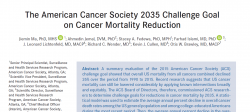Press Releases

The greatest pay-off in terms of cancer deaths prevented is through continued work on tobacco control
The American Cancer Society has set a challenge goal to reduce overall cancer mortality 40% between 2015 and 2035, a goal set by applying favorable cancer mortality trends among college graduates to the population as a whole. The goals report is published early online in the ACS’s peer-review journal, CA: A Cancer Journal for Clinicians.
In 1996, the American Cancer Society set a challenge goal to reduce mortality from all cancers combined in the United States by 50% between 1990 and 2015. An evaluation at the end of that period found mortality rate declined 26% over that time. Recent research suggests that cancer mortality in the U.S. can still be lowered considerably by applying known interventions broadly and equitably. In light of that, the ACS Board of Directors commissioned ACS researchers to determine new challenge goals for reductions in cancer mortality by 2035.
Using statistical modeling, ACS investigators first estimated the average annual percent decline in overall cancer death rates during 2001-2015 among the U.S. population at-large (1.5%) and among Americans with a college education (2.6%). They then applied the faster decline among those with a college education to the entire population starting in 2020 to project future potential improvement, estimating that death rates in 2035 would drop by 38.3% (approximately 40%) from 2015 levels. Reaching the goal of a 40% drop in overall cancer mortality could lead to approximately 1.3 million fewer cancer deaths during the 15-year span.
“The faster drops in cancer mortality among college graduates largely reflect differences in prevalence of cancer risk factors, in the uptake of cancer screening, and in access to and utilization of high-quality care,” said Richard C. Wender, MD, chief cancer control officer at the American Cancer Society and co-author of the report. “It’s clear that not all segments of the U.S. populations have benefited equally from the advances made against cancer, and that cancer mortality could be lowered considerably by applying known interventions equitably and broadly.”
The authors also map out a potential pathway to the goal. They estimate that if by 2025, the overall prevalence of several major cancer risk factors (smoking, excess body weight, low fruit and vegetable consumption, red and processed meat consumption, low fiber consumption, low calcium consumption, alcohol intake, physical inactivity, and nonadherence to evidence-based use of tamoxifen/raloxifene for breast cancer prevention) could be lowered to rates that currently exist among college graduates, and if levels of colorectal and breast cancer screening could do the same by 2030, there would be a 20.5% drop in the overall cancer death rate by 2035, achieving half the goal. If risk factor prevalence and screening rates could become even more optimal, then the overall cancer death rate could drop by 33.5%, reaching 85% of the challenge goal.
In addition to the overall cancer mortality goal, the researchers estimated challenge goals for the four cancers that together account for nearly half of all cancer deaths and have been the main driver for the steady decline in the overall cancer death rates over the past 25 years: cancers of the lung, prostate, breast, and colorectum. The goals target those sites with mortality decreases of 50% for lung cancer, 55% for colorectal cancer, 40% for female breast cancer, and 55% for prostate cancer between 2015 and 2035.
“The greatest pay-off in terms of cancer deaths prevented is through continued work on tobacco control,” write the authors. But they say the next most important effort is one to control excess body weight. “This would require a change in the behavior of the U.S. population and in U.S.’s culture of a magnitude very similar to the changes regarding smoking since the mid-1960s.”
They note though that the obesity epidemic and increasing unhealthy diets are likely to continue, making targeted interventions necessary to slow down or reverse these unfavorable trends.
Article: The American Cancer Society 2035 Challenge Goal on Cancer Mortality Reduction; Jiemin Ma, et al. CA Cancer J Clin 2019 DOI: 10.3322/caac.21564